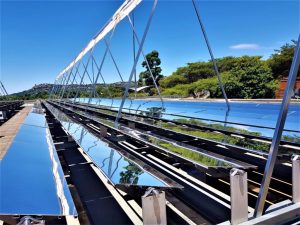Unlocking the potential of concentrated solar power with linear Fresnel reflectors
Concentrated Solar Power, a renewable energy source with immense potential, is becoming increasingly crucial in our efforts to combat climate change and transition to a sustainable future. However, the efficiency of solar power systems is a key concern that needs to be addressed in order to fully realize their potential. In this context, Linear Linear Fresnel Reflectors (LFR) are emerging as an innovative technology, capable of maximizing the efficiency of solar energy conversion.
Linear Fresnel reflectors, named after the French physicist Augustin-Jean Fresnel, are a type of concentrated solar power (CSP) technology. Unlike traditional solar panels that directly absorb sunlight, LFRs use a series of long, thin, flat mirror strips to reflect and focus sunlight onto a fixed, higher-positioned receiver. The concentrated sunlight is then used to heat a fluid, which generates steam to drive a turbine and produce electricity.
The advantage of LFRs lies in their simplicity of design and cost effectiveness. By using flat mirrors instead of curved ones, manufacturing and installation costs are significantly reduced. Additionally, the linear configuration allows for more efficient use of land, making it a viable option for large-scale solar parks.
However, the true potential of TRFs is unlocked when we delve into their ability to improve the efficiency of solar energy systems. The concentration of sunlight on a small receiver increases the intensity of solar energy, thus raising the temperature of the fluid to a much higher level than conventional solar thermal systems. This results in higher thermodynamic efficiency, meaning more electricity can be generated from the same amount of sunlight.
Additionally, LFRs can operate at high temperatures without the need for complex cooling systems. This is due to the small surface of the receiver, which minimizes heat loss. As a result, LFRs can maintain high operating efficiency even under extreme conditions, making them a reliable solution for regions with high solar radiation.
Another notable feature of the LFRs is their compatibility with thermal energy storage systems. The heat generated by concentrated sunlight can be stored in a variety of materials, such as molten salts, and used to produce electricity when sunlight is not available. This ability to store and send power on demand addresses one of the biggest challenges in solar power: intermittency.
In recent years, there has been an increase in the deployment of LFRs in solar power plants around the world. From Spain to India, these reflectors are proving their worth in harnessing solar power more efficiently and cost-effectively. As research and development efforts continue, improvements in mirror design and receiver technology are expected to further improve the performance of LFRs.
In conclusion, linear Fresnel reflectors represent a promising solution to maximize the efficiency of solar energy systems. By concentrating sunlight, operating at high temperatures, and allowing for thermal energy storage, they overcome several limitations of traditional solar technologies. As we strive to unlock the full potential of solar power, the role of TRFs will undoubtedly be critical.






